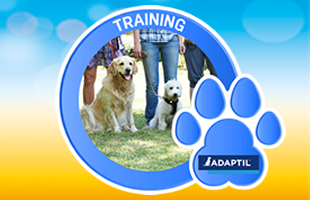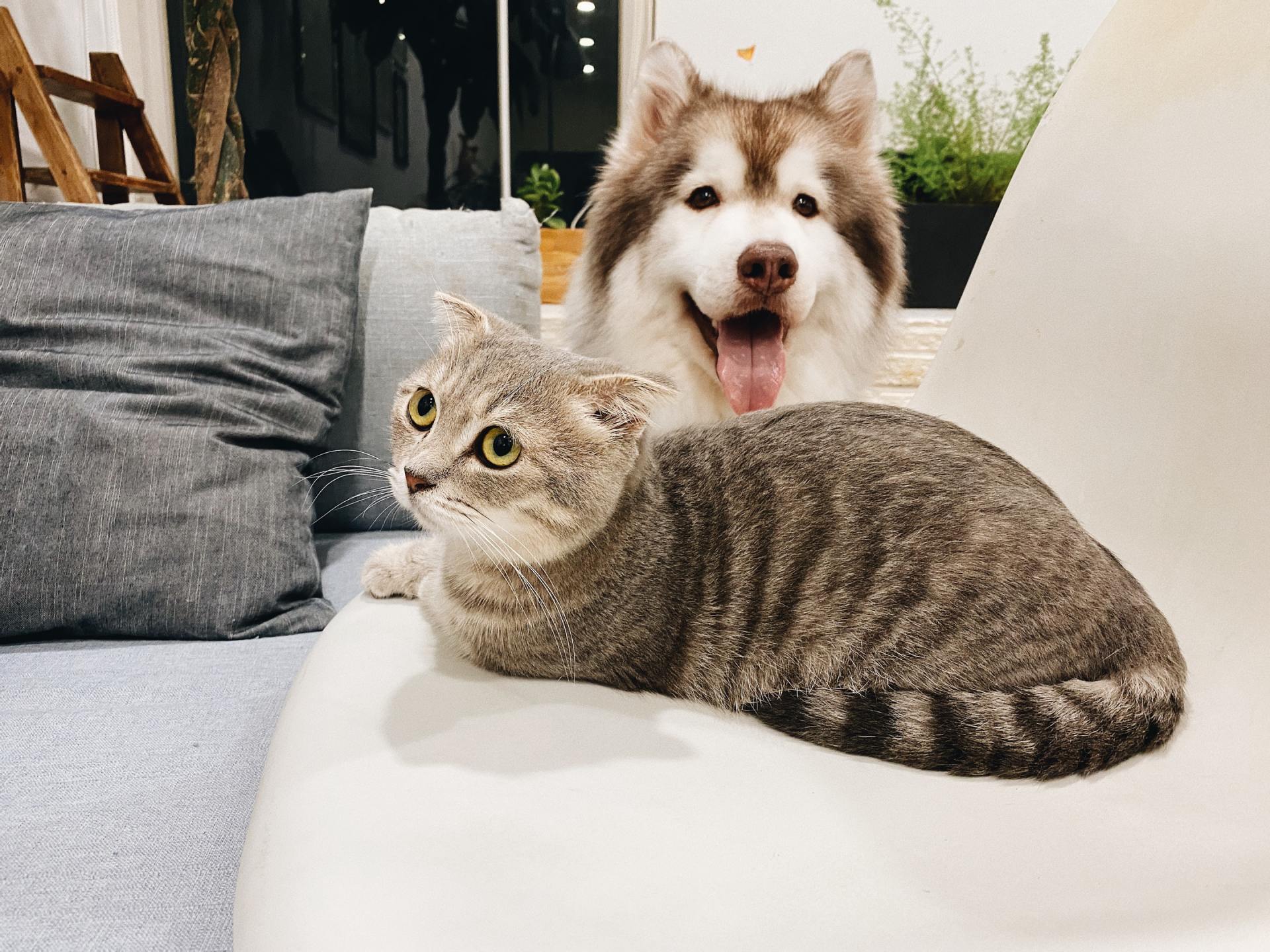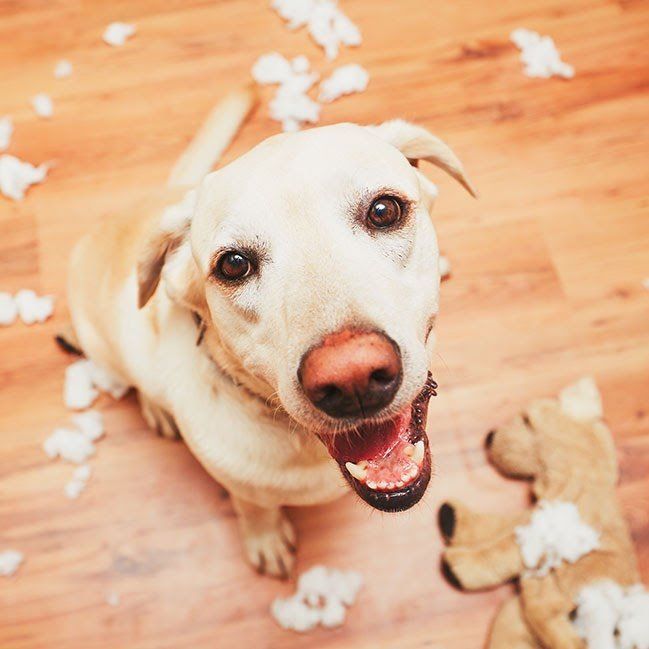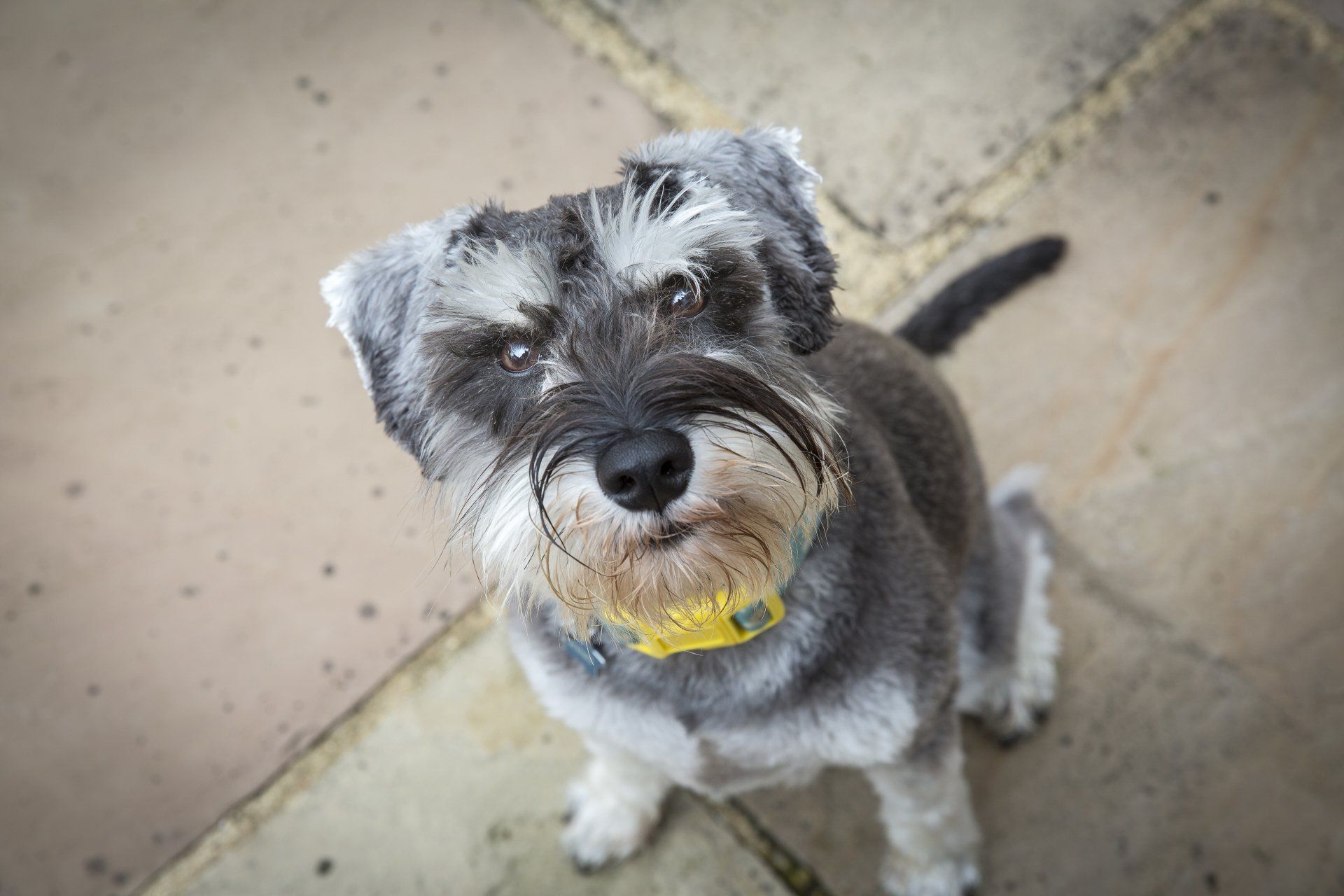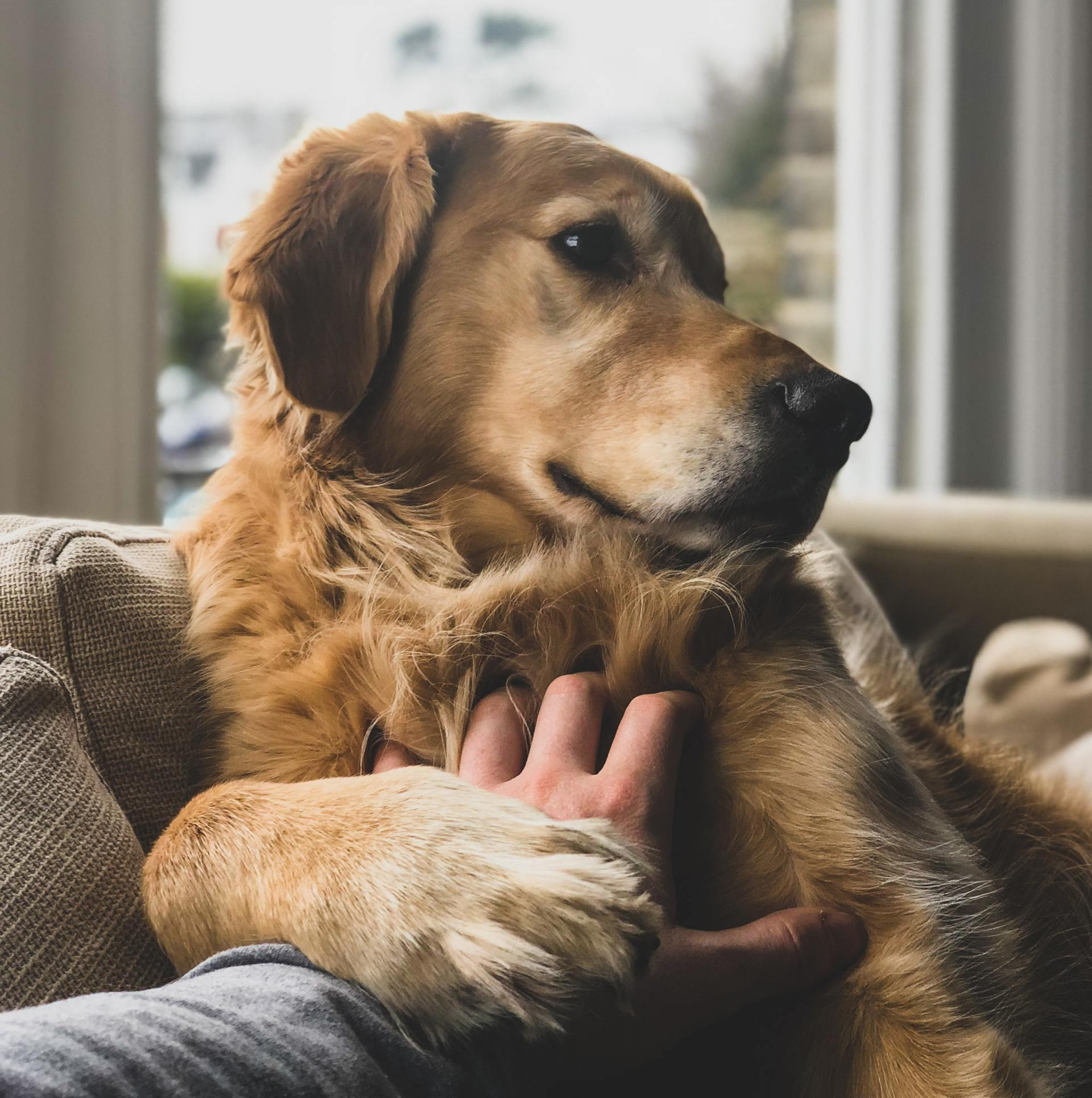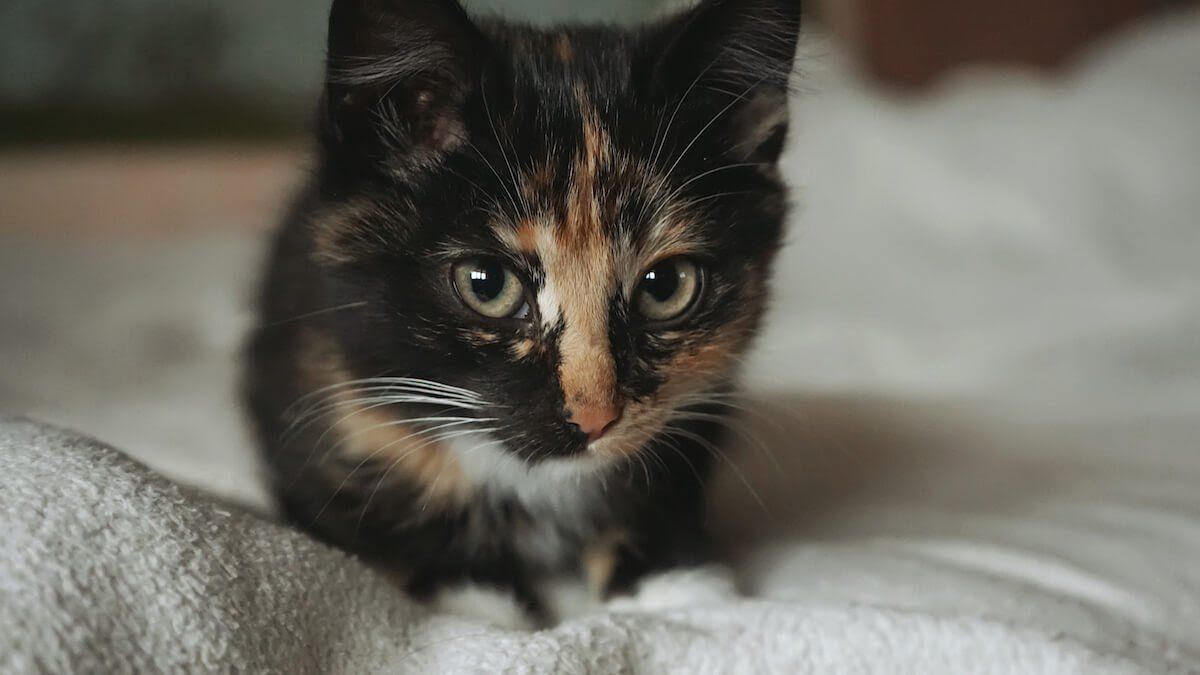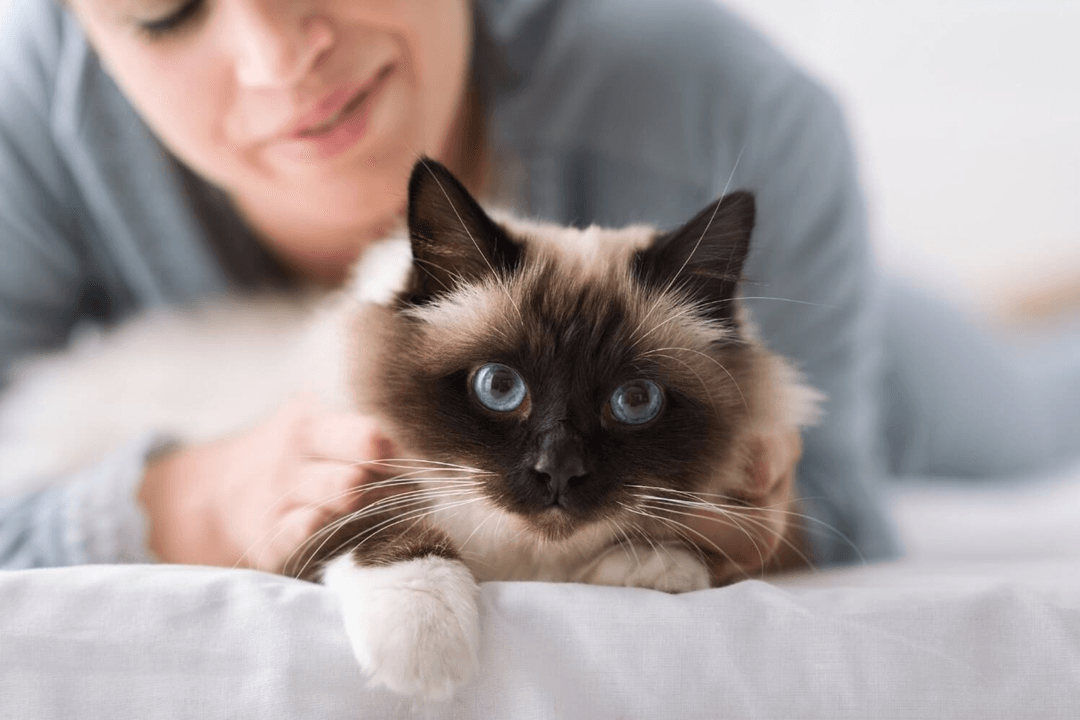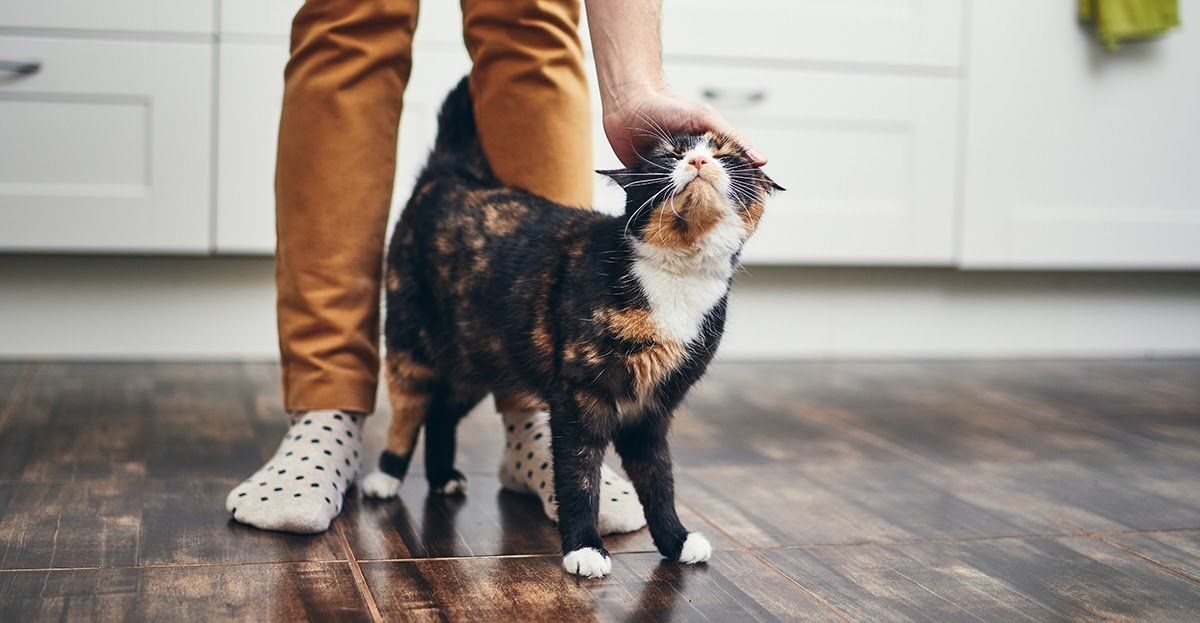Advice
Advice
Challenge
Challenge
Need advice? Read our blogs below.
New Puppy Owner?
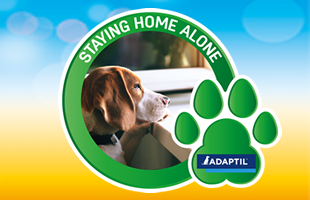
Dogs are social animals so when it comes to being alone for long periods it can be challenging for them. There are a few things you can do to help them learn that being alone isn't so bad. What to provide: 1) A comfortable place where your puppy can stay alone safely. Use a crate big enough for a sleeping area and a toileting area or make a pen or just a puppy-proofed room e.g. a utility room. You want to make sure there are no wires that can be chews or any other item you would not want to be ruined. They will need an area to move around in, access to water and toys. 2) Distractions to keep them occupied are ideal. Provide food-stuffed toys or kongs filled with frozen liquid food (yogurt, chicken stock, mashed banana, dog-safe peanut butter etc.) to encourage licking behaviour as this is self-soothing. 3) Leave the radio or TV which will keep them company and also cover up any outside noises they may bark at. 4) Departure and homecoming: Initial daytime departures should be when your puppy is tired and likely to sleep (they sleep a lot so this is easier). When you return, wait until your puppy is calm before interacting with them. Do not ignore them if they are distressed. If persistent then try a simple command followed by a treat to calm them down. It is better not to make a big deal about your return. Make sure all 4 paws are on the floor when you reward them. 5) Simple cue is an option to help your dog understand that you are going out. For example a wave and ‘bye’ or an index finger and ‘i’ll be 1 minute’. If you want to find out what your dog is getting up to or how they are coping when alone then consider asking neighbours to keep an ear out if they are around. Another option would be setting up a doggy camera so you can monitor. You might find out that something in particular sets your dog off when you are not there, for example post through the door. If you do find any destruction when you return then just ignore it, it isn’t personal and they’ve only destroyed it because they were so stressed that they reached the point that they had to express it. Never tell them off as this will just increase their stress and make things worse. You can help train your dog to be alone by starting small, even in a separate room and keep out of sight for a short while. Weh you are confident they are quiet return and provide a treat. Build this up so you are out of sight for longer periods and reward if they are calm, haven’t made any mess/destruction and haven’t barked. If they do bark or whine then do not return to them. Until they are quiet. If you reward the wrong moment, they will learn that if I bark or whine, then you will return, which is what they want and therefore will do it again. Remember that every dog is different and for difficult cases it is recommended to speak to a qualified dog behaviourist and speak with your vet.
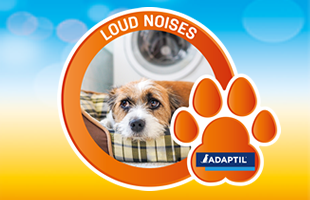
You want to train your puppy to accept unusual noises and other “scary” things. You want to begin this slowly, you can desensitise them to accept noises. If your puppy is surrounded by a busy noisy environment, distract them with toys and reward good and calm behaviour. For outside noises like fireworks or thunderstorms you can try and get them used to the noises as long as it is well away from the busy firework period. Using a programme to do this is ideal, it is available as a free resource from the Dogs Trust you can also purchase as a CD. Make sure you introduce this gradually. Exposing your dog to sounds of fireworks, rain, gunshots, thunder and much more to quickly could build up a fear. Start super quiet, at the volume they can barely hear. Day after day, increase the volume gradually and stop increasing the volume if they seem to react badly to it. Reward your dog when they respond well. This process can take quite a long time, so it is better to do it long before or after the firework season. If there is a sudden episode of thunder or fireworks help mask the noise by closing curtains and turning the TV/radio on and distract them with treats and toys. We have more tips for fireworks night here .
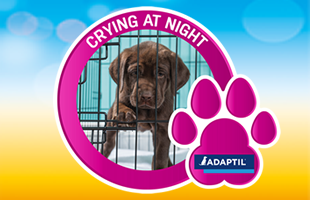
Create a “puppy bedroom” Choose a warm and comfortable sleeping space for your puppy with a bed and/or a blanket. It can also be beneficial to place something that smells of you like an old t-shirt in their bed to provide additional comfort. The transition throughout this period can be a long process and may take time for your dog to stop crying and become quieter and therefore will need a lot of your patience. If there is still whining when left alone, start to time the duration of the time they are crying, then you can monitor and note how long they take to quiet down. Keeping track of progress is beneficial to see if things are improving over time. Preparing for bedtime: 1) Give them dinner early, ideally 3 hours before bedtime, this will help them not to need the loo overnight. Limit food and water, do not give them any an hour before bedtime. Going to bed with a full stomach and bladder means you'll likely be taking your pup out more than once during the night to let them out. 2) If you are early to bed and late to rise, you'll have to make at least one midnight trip to keep them from going to the bathroom inside, but as your puppy gets older and gets used to the toilet training this will become less frequent. 3) Provide active play and a walk is possible, 2 hours before bedtime - this will help tire them out. Make sure your puppy is getting lots of physical and mental exercise, especially if your puppy is a particularly active breed and as your puppy gets older. 4) Try not to be too excitable to help calm them down. Wait until they are naturally sleepy before leaving them, puppies sleep a lot so this should be easy. What NOT to do: -If your puppy cries, wait to see if they settle down before going straight to see them. If you go to see them every time they cry, they will learn that their crying will achieve this. -Start as you mean to go on, if you want them to sleep in a separate room then avoid letting them sleep in your room at all...they don't know what they have never had. -Never use your puppy’s bed as a punishment, this could create stress at bedtime. If your puppy seems extremely stressed, they may not like their crate, being alone and away from you, the room, or a room separate from you. You could provide a puppy pen or area near your bed/bedroom. This can make your puppy feel more comfortable and less stressed as they are closer to you throughout this adjustment process. However, if your dog is sleeping in the same room as you, the transition to being a quiet pup that doesn’t bark when left alone can be a longer one. You will have to work on this and be patient. If your puppy cries, wait to see if he settles instead of coming to pet him. Otherwise your puppy could learn the wrong lesson that crying will get him cuddles! If you want them to sleep in separate rooms then avoid letting them sleep in your room, otherwise they will ask for it again.
Every successful product is the fruit of hard work and this applies to every field of business. Intuition alone is not enough to create a product that people will love and use. You also need to do your research, thinking, planning, differentiating yourself and more. Write about some of the challenges you faced in designing this product and what steps you and your team took to overcome them.
Information for dog ownersners
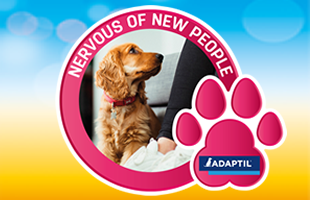
If your dog is nervous of visitors, then it's almost understandable, it's their home and they didn't invite a complete stranger to come into their home. Guests are a break in the dog’s daily routine and therefore are very exciting or scary. Depending on your dog’s temperament, the guests might be perceived as trespassers. For some cases it is not always a simple fix, especially if your dog has reacted in a certain way for a long time. It is advisable the advice of a vet or qualified behaviourist to help you put a plan into place to ensure you are reacting and rewarding in the right way. The earlier you can tackle this, the better. What you can do: ● When visitors are over it’s important to teach your dog what you want them to do. Give your dog clear instructions and remember how you want them to act in the situation e.g. no jumping up. Short-term you can use a barrier or gate that will separate your dog from the front door. This won’t replace training, but it will help while you’re working on this behavior. ● Leave a sign outside and a pot of treats for visitors to give your dogs when they come in, if safe to do so. Your dog could soon learn that visitors arriving is a great thing, as I get rewards! Tell all guests this before they arrive and after a few minutes or after a while if your dog is still being calm and relaxed then you can allow your visitors to throw your dog treats. ● Ask guests to ignore your dog completely, this includes no petting, talking, looking at or treats. Your dog can get fearful if the visitors come straight in and to them. Ask your visitor to only interact with your dog when your dog has gone to them or when you are all sitting down after a while and the dog looks calm. Do not allow your visitors to follow or pursue your dog, if your dog is trying to get away or hide or in their safe haven. ● Don’t force your nervous dog to stay too close to the source of fear and do NOT punish your dog if they barks or shakes, this will only make your dog more distressed. Mild and positive exposure is best, your dog will then learn over time that there is nothing to be afraid of. ● Go slowly when exposing them: first approach the fearful thing from a good distance. Reward when they remain calm and DO NOT force them to continue if unhappy. Over time move closer continuing with all the rewards when behaving well. The goal is to have your dog in a relaxed position when visitors arrive and to enjoy the visit. Therefore, you want to teach your dog that they should stay calm and give interactive relaxed behaviours with your visitors to get rewards. Use your dog's bed or safe haven as a comfortable place that your dog associates with wonderful things and use this as a training tool. Providing distractions or things that are more interesting such as puzzle toys, stuffed or frozen kongs filled with high-value treats like chicken or peanut butter (dog-friendly) is a long-lasting option. Begin to practice this in different scenarios; especially at the front door or in distracting situations. Recruit someone else to help, a family member, friend, or neighbour to help you. Always have yummy treats in your pocket and provide them to your dog whenever they are relaxed or calm. Ask your helper to ignore your dog at all times unless the dog walks over to them and is calm and seeks their attention. Then have the helper go back outside and repeat the exercise. If at any time your dog gets distracted, ask him to sit/go to their bed or a calm behaviour and reward after. Always provide these lasting high value food puzzles or treats before a planned visitor arrives, they should soon start to associate the positivity with the visitor or keep distracted to a point where visitors don’t matter or aren’t a worry.
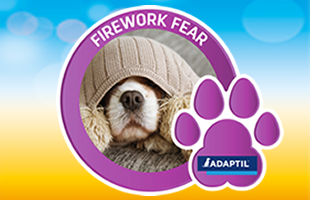
Fireworks can be scary for people, so imagine how dogs feel with sounds which are so much louder to them with their incredible ears. Firework fears are very common in dogs. Signs to look out for sound sensitivities or fears during loud noises like fireworks include: ■ Trembling and shaking ■ Clinging to owners ■ Whining or barking excessively ■ Cowering & hiding ■ Trying to run away ■ Soiling inside the house ■ Pacing and panting ■ Refusing to eat ■ Ears back ■ Drooling What to do: -Dogs enjoy a calming area to go as a 'safe place', just like their own den in the wild. If they go there you don't have to follow or give them attention, just leave cosy blankets, bedding and a favourite toy and give them space, a crate is ideal for this! -If your dog will accept food or toys during these loud times, then leave a kong or food puzzle to keep them occupied. Try to reduce the impact on your dog by keeping them inside with all the curtains, windows, doors closed and turn on the TV/radio to mask the sound. -If you know the fireworks are coming, walk your dog early in the light and avoid having them outside, even in your garden during the events. -Make sure your dog’s microchip is up to date in case they get scared and run out of fear. -Be caring if your dog comes to you for support, offer genuine affection without being too sympathetic. Keep the mood light without too much concern that may transfer you are worried too. As soon as your dog has calmed a little, try to distract them into a game with a toy or into using their nose to find a treat. However it is best to keep your distance from a dog that is hiding or cowering away behind furniture or in their safe haven den - they are there to get away and be alone. -Don’t leave your dog alone, just knowing you are there and your presence will be reassuring to them. -Do NOT punish your dog, even if they make a mistake, this will increase their worries! The best thing to help your dog with loud sounds and fireworks, is to carry out a desensitisation programme you want to do this early, as a puppy or at least 6 months before the fireworks season. Even though habituation and training to get used to sounds is best done with dogs when they are puppies you can still help when they are older. Use the ‘Sounds scary’ free download resource from The Dogs Trust. Please consult your veterinarian if your dog has severe signs or really affected by fireworks, or local accredited behaviourist for help and advice.

Dogs are social animals so when it comes to being alone for long periods it can be challenging for them. There are a few things you can do to help them learn that being alone isn't so bad and help them get used to it. Provide a comfortable 'safe place' where your dog can stay alone and ensure it is a nice place for them to be, full of cosy blankets, chew toys, food puzzles and other distractions to stay occupied. Consider playing music (something light, light classical or where there is a lot of talking). When you do leave, which everyone will have to do at some point, try not to make a big deal about leaving or when you come back. To help them learn that it's not worrying or a fuss to be alone and that they can be calm and play until you return. When arriving only provide attention and fuss when they are calm and all 4 paws are on the floor. If this is quite hard as they are extremely excited for your return then ask for a simple command that requires them to be still or calm, such as a sit and then after they follow this calm command that you've asked them, provide a treat. After a while when you return and frequently provide treats for 4 paws to the floor or for a calm command they will provide these more often. Another option to help your dog understand that you are going out is to add a simple cue to let them know that you are going. For example a wave and ‘bye’ or an index finger and ‘i’ll be 1 minute’. Provide food-stuffed toys or kongs filled with frozen liquid food (yogurt, chicken stock, mashed banana, peanut butter etc.) to encourage licking behaviour as this is self-soothing and can help calm them without you there. If you want to find out what your dog is getting up to or how they are coping when alone then consider asking neighbours, if you are close with them, to keep an ear out if they are around and nearby during the day. Maybe a better option would be setting up a doggy camera so you can monitor them while you are out and see what they get up to. You might find out that something in particular sets your dog off when you are not there, for example post through the door. If you do find any destruction when you return then try to ignore it, it isn’t personal and they’ve only destroyed it because they were so stressed that they reached the point that they had to express it through that way. Never tell them off as this will just increase their stress and make things worse. You can help train your dog to be alone by starting small, even in a separate room and keep out of sight for a short while, then when they do not bark return and provide a treat. Build this up so you are out of sight for long periods and reward if they are calm, haven’t made any mess/destruction and haven’t barked. If they do bark or whine then do not return to them if you can and definitely do not reward them. They will learn that if I bark or whine, then you will return, which is what they want. and therefore will do it again. Remember that every dog is different and for difficult cases it is recommended to speak to a qualified dog behaviourist and speak with your vet.
Lockdown Advice for dog owners
Information for cat owners
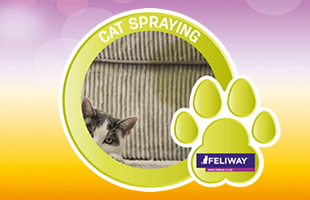
Why does a cat spray? Spraying is perhaps the most misunderstood cat behavior, often confused with urinating. Spraying cats emit a foul smelling spray for territorial and calming reasons. The strong smell or even just performing the act and reduce stress or comfort your cat. The cat will usually choose vertical places to spray, have their backside raised & quiver their tail. Urine spraying is an indication that a kitten is now an adult. Who will spray? Both males and females can spray, even after neutering or spaying. Entire female cats sometimes spray to highlight their territory and to tell males they’re available. Males are available at all times and spray to leave urine marks as a territorial behavior, but this is also a sign of his availability to nearby females. Can be in combination with meowing and yowling, calling to available female cats in the area. Kittens begin spraying urine usually when they hit reproductive maturity. This stage varies, but ranges from around 4 months to over a year. Neutering or spaying a cat before reaching maturity can help prevent spraying, male cats usually mature physically between 4 to 5 months. Most cats begin spraying around 6 to 7 months of age, but if the cat is neutered before it ever sprays, it very likely will never begin spraying at all or develop a habit. It is still possible for cats to spray after they’ve been neutered. Therefore it is best to train your cat before they start spraying and create a positive reassuring environment to comfort your cat so they can cope through all the changes in your life together. What to do if you cat is spraying If your cat is already spraying, they are most probably uncomfortable and there is a stressor causing this. Help by removing whatever they have perceived as a threat or whatever is making them uncomfortable and stressed. Try and work out what may have changed in their environment most recently e.g. a new sofa Cats usually spray in response to anything that is making them stressed or they think of as a threat, can be anything from decorating the house, to a new animal around or a guest. Clean all cat marks With warm water and soap (enzymatic wash) or alcohol Let the area dry, do not use bleach! Using ammonia-based or bleach cleaners will attract your cat to spray again. You should see an improvement within the first week and continue to use for at least one month. Adhere to the litter box guidelines : ● One per cat plus 1 more ● Easy to access ● Locate away from food and water ● Always clean: Scooped daily and cleaned weekly. Remove any stressful changes in their environment - changes in your cat’s environment Any unavoidable new environmental changes should involve slow introductions and keep your cats routine as normal as possible. Feliway Classic should be used to mark the environment as safe and secure when any changes are being made. Health Problems Get your cat checked at the vet for any underlying health problems. Especially if the spraying perseveres despite being neutered and environmental issues addressed. Other things to look at: ● Look for litter box-related issues as your cat may be avoiding their litter box for a reason. Try adding another litter box or changing the location of the litter box or the litter you use. ● If a multicat household, ensure there are enough litter boxes so that each cat has one without conflict or competition for it. ● Blot the urine spray right away with a clean towel to soak up as much urine as possible, reducing the possibility of the pee soaking in. Use a cloth or towel that you can either immediately wash or throw away. If the spray is dry or on carpet, pour a cup of slightly warm water and wipe up with towels before adding cleaning products. Blot the stain and do not rub, as this would cause the stain to set or soak in.
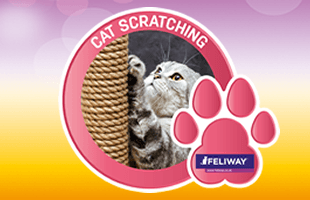
Why does my cat scratch? Cats do need to scratch, it is a natural need and helps them sharpen and flex their claws. However cats can scratch inappropriately or excessively as a subtle way of showing that they are not completely happy. How to know if its stress scratching If scratching is widespread in your house or your cat is particularly destructive, this may be an indicator that this may be due to stress. If this has begun all of a sudden try and work out if something has changed suddenly in their environment e.g. a new sofa.
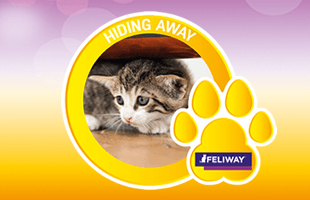
Cats like to hide when they are stressed so while dealing with the causes, make sure that you provide multiple cat hiding places (Cardboard boxes, baskets, open cupboards etc.). Cat hiding places should always be accessible to your cat and they prefer high places. Always respect your cat’s decision to hide and do not force them to come out. Understand why your cat may be hiding ● Recent changes at home? (new furniture, redecorating, moving home...) ● Visitors, ● A new family member, ● A new pet at home ● Competition or tension with another cat? Cats hiding can be completely normal and maybe nothing to worry about. They could also actually be sleeping; maybe your cat just likes that spot under your bed for some warmth, peace and quiet and finds it a nice safe place for an undisturbed snooze. However, this would mean that your cat doesn’t spend all their time there and when under the bed, they are relaxed and always sleeping there, so look out for their body language and any signs of stress or tension. Cats spend much of their day napping, so they may choose this private, comfy place to curl up to conserve body heat and hide themselves from potential threats. If something has changed or is new this perceived threat is not taken lightly (as they are natural prey animals) and they will hide, for example under your bed for safety until they realise that it is safe and this is not something that should be feared. Meaning your cat will come out after a while. If your cat hides often or there hasn’t been any additions, visitors or changes to their schedule or environment. Then take your cat to the vet for a check up, it could be a sign of pain e.g. dental. Try to comfort your cat at home and create the most comfortable calm environment as possible. Cats can hide because they feel stressed and anxious What not to do: ● Do not scold, shout or swat or force your cat to move or do anything to control/correct them, this will make things worse. Cats will perceive this negative punishment as a threat and act fearfulling with avoidance or aggression. ● Do not forcibly remove your cat from her perceived safe area. They are in this area as it makes them feel safe and cats feel less stress when they are able to choose movement and are able to move freely. Lessening stress will likely decrease the cat’s hiding behaviour. ● As tempting as it can be, do not stroke or soothe your cat during the hiding. You may accidentally reinforce this with the praise and increase your cat’s want to hit. Instead, try to ignore the cat and give them space. What to do: ● Do praise your cat for bravery and for any other behavior you want more of. ● Think of ways you might make it worthwhile for your cat to come out of hiding. Call your cat for meals and treats. If your cat will eat near you, try hand feeding your cat. Lack of appetite is one sign of stress. If the cat won’t take food from your hand, try sitting quietly near your cat and tossing an occasional treat. If your cat takes the treat, toss the treats closer to where you are sitting. Over time, the cat may take the treat from your hand. If all of these suggestions fail to reduce your cat’s hiding behavior then make sure you visit with your cat frequently to give mental stimulation and ensure he or she is getting nutrition, water and access to the litter box. Or, consider giving your cat a private room that is people and pet free. Make that private room a cat sanctuary that has everything your cat needs for comfort and security. Always take your cat to the vet if you are worried
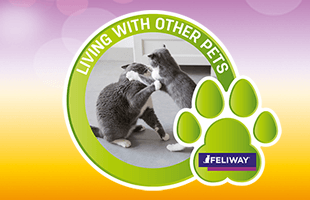
Follow our “golden rules” on resources. Duplicate: each cat must have their own food bowl, water bowl, litter box and scratching post Separate: Spread your resources around the house. Ensure each cat has it’s own SEPARATE “dining room” and “bathroom”! This provides each cat with some privacy. Use the whole room. You can put some bowls higher up and some lower down to provide space. Conflict management, DO NOT punish your cats when they show signs of conflict. This would cause stress and therefore lead to more conflict. Provide more than one method of escape (exits) in each room. Also can provide covered walkways or tunnels so cat’s can get around and avoid conflict. Provide plenty of places to hide/rest and perch. If conflicts cause signs like urine spraying or scratching. If your home has frequent house fights, it's important to do your best to stop it. For your cat’s health as well as you. This is a process that may require patience and work at training them as it can take a lot of time. But stay with it as it may get you your desired outcome, however also be aware that some cats are completely solitary and may never get along. Cats are naturally solitary animals and can be very territorial. The fighting may occur due to territory. Observe the cats carefully to see if you can pinpoint when and where the unwanted behavior happens. For example, does it happen around mealtimes or when you are giving attention to one of the cats? You can help by adding more territorial space and spaces for your cats to go out their day, sleep and pass one another peacefully or escape one another. This can prevent the cats from having to share climbing, hiding, and perching areas where fights can break out. And prevent stress or avoidance from fear of conflict. You should increase resources, your cats should have minimum and separated.. food and water bowl each and one litter box each if not more, scratching post each and toys or cat trees/perching areas. The more the better and in different locations. If one cat is the aggressor try and intercept things before they occur or get bad. Redirect their behavior with an interactive toy/string and lure it into play. You can also interrupt with a sharp and short sound or ‘no’ and once they are away and cam, then you can reward this good non-violent calm behavior with fuss, food or a fun toy. But avoid rewarding behavior you don't want to see. Try not to give food or toys after the fight has broken out. Seeking help from an animal behaviorist may be very helpful to work out what to do, how to manage and control this situation. A visit to the vets may be necessary. Some health issues can make cats angrier than usual as a symptom. Especially if they have only just recently started not getting along when they used to, or if your cat has now become more aggressive. Treat the cats as though introducing them for the first time. GIve them their own areas and then make slow and short introductions. Use controlled situations to expose the cats to each other. Make sure the cats always have an exit to make them feel comfortable and allow them to leave if things get too much. Try to slowly see one another and then progress to being in same room whilst both being fed cats tasty foods or try to get them to engage in play so they associate being near one another to fun and positivity. Never force them into or to leave a situation. Give each cat one-on-one attention. If necessary, put one cat in another room while with the other cat. During one-on-one time, hand-feed treats or initiate playtime.
Every successful product is the fruit of hard work and this applies to every field of business. Intuition alone is not enough to create a product that people will love and use. You also need to do your research, thinking, planning, differentiating yourself and more. Write about some of the challenges you faced in designing this product and what steps you and your team took to overcome them.
